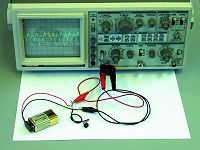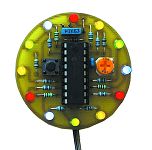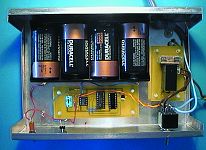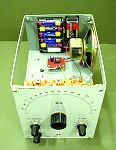
![]() Teach-In
2004 (1) - "How to Apply Electronics Meaningfully". Our
brand new educational series is specially written to introduce beginners
and students to the exciting world of electronics.
Our hands-on tutorial spans ten months in total, and offers you a hands-on
opportunity to get to grips with modern electronic components in a variety
of practical demonstrations.
Teach-In
2004 (1) - "How to Apply Electronics Meaningfully". Our
brand new educational series is specially written to introduce beginners
and students to the exciting world of electronics.
Our hands-on tutorial spans ten months in total, and offers you a hands-on
opportunity to get to grips with modern electronic components in a variety
of practical demonstrations.
Teach-In 2004 adopts the "systems approach" which is ideal for teaching younger students and electronics novices alike. This encourages you to make a practical start to using electronics devices in a "black box" system design rather than concentrating on the complex mathematics or physics associated with the parts. If you're new to electronics and want to learn more, Teach-In 2004 will be the ideal way to get started! Will also use microcontroller-based circuitry, preprogrammed for simplicity.
![]() FREE
DOWNLOAD - READ PART ONE OF TEACH-IN 2004 FOR FREE! You can also buy
Back Issues through our Online
Shop, so you won't risk missing any previous installments. Subscribe
now - we accept most major credit cards and we deliver worldwide.
FREE
DOWNLOAD - READ PART ONE OF TEACH-IN 2004 FOR FREE! You can also buy
Back Issues through our Online
Shop, so you won't risk missing any previous installments. Subscribe
now - we accept most major credit cards and we deliver worldwide.
Be sure not to miss this electronics tutorial series, specially written for students, hobbyists and anyone wanting to learn how to use electronic components!

![]() PIC
Random LED Flasher -
Enjoy the fun of an interesting and attractive pattern display! Our PIC-powered
mini circuit drives yellow, red, blue and green light-emitting diodes
to provide a dazzling flashing display. Perfect for novelties, decorations,
toys, jewellery and more. The small circuit can even be worn as a badge
or necklace.
PIC
Random LED Flasher -
Enjoy the fun of an interesting and attractive pattern display! Our PIC-powered
mini circuit drives yellow, red, blue and green light-emitting diodes
to provide a dazzling flashing display. Perfect for novelties, decorations,
toys, jewellery and more. The small circuit can even be worn as a badge
or necklace.
![]()
Our fully detailed constructional article walks you through the source code creation, and of course all practical constructional details are provided to enable you to assemble the project with every hope of first-time success.
![]()

![]() Anyone
At Home? - This burglar deterrent device is battery operated and causes
a mains-operated lamp (e.g. a table light) to switch on and off randomly,
to give the impression that the building is occupied. All parts are p.c.b.
mounted for ease and safety of construction.
Anyone
At Home? - This burglar deterrent device is battery operated and causes
a mains-operated lamp (e.g. a table light) to switch on and off randomly,
to give the impression that the building is occupied. All parts are p.c.b.
mounted for ease and safety of construction.
Two circuit boards carry the small 4000 logic circuit and mains p.c.b. relay.

![]() Cardboard
Clock - An intriguing and novel way in which you can watch time passing
by! The article describes the evolution of electronic clock circuits,
including the Kienzle single transistor clock circuit.
Cardboard
Clock - An intriguing and novel way in which you can watch time passing
by! The article describes the evolution of electronic clock circuits,
including the Kienzle single transistor clock circuit.
Full constructional and assembly details are supplied, including all drawings and diagrams to enable you to build the Cardboard Clock from scratch. An interesting project for hobbyists everywhere.
![]() PLEASE
TAKE NOTE In the December 2003 issue, we said, Use normal thin card
for the clock wheels as thick (art supplies) card may be too heavy and
stop it. Use a rectangular file to make the grooves that support the wheels
axles. Depth is correct when a screw laid in the groove is half buried.
Point "D" is the 15mm horizontal section of suspension hook W2. Cement
end B of the pendulum post (A1) to the backboard. For the pendulum rod
start with a 1 metre length of 24 s.w.g. wire, and draw (stretch) it slightly,
to straighten it. Before bending it, mark the bend points with a pencil.
The letter p shows on which side to position the pliers, when making bends
Q and R. When readjusting the coil table rely on the rubber band, and
not on the bolt through hole E.
PLEASE
TAKE NOTE In the December 2003 issue, we said, Use normal thin card
for the clock wheels as thick (art supplies) card may be too heavy and
stop it. Use a rectangular file to make the grooves that support the wheels
axles. Depth is correct when a screw laid in the groove is half buried.
Point "D" is the 15mm horizontal section of suspension hook W2. Cement
end B of the pendulum post (A1) to the backboard. For the pendulum rod
start with a 1 metre length of 24 s.w.g. wire, and draw (stretch) it slightly,
to straighten it. Before bending it, mark the bend points with a pencil.
The letter p shows on which side to position the pliers, when making bends
Q and R. When readjusting the coil table rely on the rubber band, and
not on the bolt through hole E.

![]() Practical
Radio Circuits (6). Single-sideband and direct conversion. Our expert
radio writer describes another superb receiving system for the set builder
and experimenter. A 7 MHz (40m) FET amateur band receiver is included
along with all practical constructional detail needed. Another excellent
and challenging project for the EPE radio enthusiast!
Practical
Radio Circuits (6). Single-sideband and direct conversion. Our expert
radio writer describes another superb receiving system for the set builder
and experimenter. A 7 MHz (40m) FET amateur band receiver is included
along with all practical constructional detail needed. Another excellent
and challenging project for the EPE radio enthusiast!
Don't forget you can buy back issues from our Online Shop, so you can enjoy all the earlier parts of this very comprehensive series.
![]()